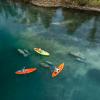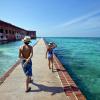By Saundra Amrhein
Myakka City, Fla. – A few hours after the sun burns morning dew from the grass, Gabriella Herrmann walks through the stables, taking a final look over her stallions to make sure they’re ready. In knee-high black boots and riding pants, she pats the hard muscles of their white shoulders and flanks.
Herrmann, 58, feels their nervous energy and a connection with each animal – a connection her father long held and that took her years to earn. It’s a connection also sought, at least briefly, by the hundreds of people flocking this way.
What the arriving spectators are about to see, Herrmann tells them moments later under a brilliant blue sky and warm sun, is “living art and poetry in motion.”
By 10 a.m. on this morning, more than 300 visitors from across the state and nation have come to watch the Royal Lipizzan Stallions at their winter home on this 25-acre ranch 22 miles east of Sarasota in Central Florida. In the five decades since moving here from Europe in 1962, the Herrmann family has welcomed a curious public to witness the stallions rehearse in preparation for their summer tour seasons through the Northeast.
For years, thousands were drawn here by word-of-mouth to view the dazzling maneuvers of the rare white stallions. The Lipizzans were bred in the 16th Century by the Hapsburg royal family of Austria. A Herrmann ancestor, a knight, was given a Lipizzan stallion as a gift 300 years ago.
Ever since, Lipizzans have remained in the family. Some were among those saved by Herrmann’s father and grandfather alongside General George Patton’s operation to protect and smuggle horses behind enemy lines during World War II – a dramatic mission depicted in the Disney movie, “Miracle of the White Stallions.”
Today the crowds carry coolers and lawn chairs, which many perch in front of packed bleachers along the fence perimeter of the rehearsal arena, which Herrmann jokingly calls the “splash zone,” for the horses’ tendency to blow through their noses as they pass.
Over the next hour, the stallions gracefully prance, trot and canter in the fenced arena under the direction of a handler – at one point three of them in unison performing a ballet-like Pas de Trois.
Meanwhile, Herrmann explains their history and European classical training. They are part of the family, and when performers are ready to retire, “they let us know,” Herrmann tells the crowd. “They give us their youth, and it’s our responsibility to take care of them in their golden years.”
The 30 stallions and mares on the ranch include those retired, along with several rescued horses.
In one demonstration, Herrmann enters the arena mounted on Desert Storm while driving Achilles on a long line in a tandem performance. Achilles prances majestically in serpentine figures. As he moves forward, he turns his head to one side, looking out at the crowd while his silky, gray mane floats behind him in the wind.
“He’s beautiful,” whispers a woman sitting in the bleachers.
“That’s a good man,” Herrmann tells Achilles after dismounting Desert Storm while apprentices give him a sugar-cube treat reserved for show time. Verbal praise in the arena – part of Herrmann’s award system along with apples and carrots – is not allowed in the competitive horse world, she notes.
Finally, it’s time for the grand conclusion – the Airs Above the Ground – elaborate and physically harrowing wartime maneuvers that predate Christ and gunpowder, when horses were used to intimidate and strike out at opposing foot soldiers with their hooves. In successive demonstrations, Herrmann guides stallions through elegant poses, including the levade – rising on haunches to a 45-degree angle – and a courbette – jumping off hind legs with forelegs in the air.
During the show, she plays the recorded voice of her father – the late Colonel Ottomar Herrmann Jr., who led these horses, feeding them carrots every night before he went to bed, treating them like his children until he died unexpectedly on tour in 2004. It took her more than a year after his death and urging from followers to use the recording in shows again. She didn’t want to upset the horses – who were distressed and grieving Col. Herrmann’s absence. She also wanted to win over their hearts on her own, the way her father had.
“They gave themselves to him,” she says after the show in a quiet moment about her father’s connection with the horses. “Even though I road them and worked them, there was a part of them that held back. It took two years after dad passed before I felt them giving themselves to me. I walked in one day and I knew.”
After the rehearsal show, the crowd is invited into the stables while the stallions and mares are fed hay. Kenedie Howard, 11, of Ormond Beach, is among the visitors handing carrots to the horses from an outstretched palm, which the horses lick generously in scooping up the treats.
“He wants some more,” her grandfather, Jim Howard, tells Kenedie regarding Nicky, who is banging a foreleg against his stall to get her attention. Howard and his wife, Linda, from the St. Petersburg area, drove their granddaughter here for a surprise birthday gift. Kenedie, dressed in a pink cowboy hat, shorts and brown cowboy boots, volunteers at a stables near her home.
Long after the crowd clears out, she is still walking from stall to stall, handing carrots to Nicky and the other stallions.
“She really enjoyed that,” Jim Howard says about the show. “But this is the best part, right here.”
If you go...
The Herrmanns’ Royal Lipizzan Ranch is located at 32755 Singletary Road, Myakka City, Florida, 22 miles east of Sarasota. For more information, call 941.322.1501 or visit https://www.herrmannsroyallipizzans.com/






























